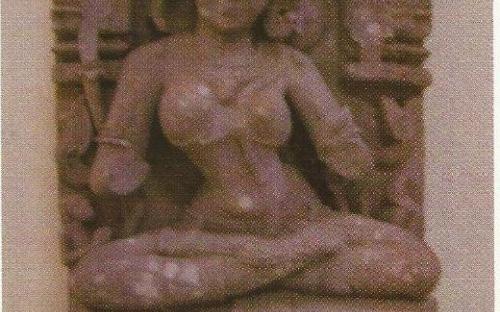Tara
You are here
Tara
This image of Tara carved out of sand stone is a good piece of sculpture in the (Odisha State Museum. It was brought from village Mangalapur of Puri district.
The image is two-armed and is seated cross legged on a double petalled lotus pedestal. But unfortunately the hands from the elbow are broken and missing. Nose, lips and cheeks are slightly rubbed off. Below the pedestal are seen two kneeling female devotees in folded hands, two male devotees of which one is in kneeling position and the other sitting cross-legged. To the extreme left side is shown another headless damaged figure sitting cross legged. In between the devotees the objects of worship such as lamps, votive stupas etc., are placed and at the centre a lotus bud, a sword, two seated damsels, a horse and one elephant are found. Two sitting devotees flank the image above the pedestal. Five Dhyani Buddhas seated in lotus pedestals one displaying Abhaya, Bhumisparsa and Dharma chakra pravartan mudras and flying Vidyadharas and female devotees decorate the figure at the top. The figure is profusely covered with decorative ornaments. The graceful appearance and detailed ornamentation of the body not only reveal the artistic merit but also enhance the feminine accomplishment of the Image.
Lokanatha-This headless image was lying buried in a plot of land situated very close to the Brahmheswar temple of Bhubaneswar. Accidentally it was located at the time of ploughing and brought to the Museum for preservation. The two hands of the image are broken. It is decked with several stringed necklaces, mukuta girdle, anklets set with tinkling bells. The drapery consists of a dhoti running up to the knees. It stands gracefully like other Avalokiteswar images of the variety.
Two female figures are standing on either sides of the image. The one on the right is in perfect condition hoiding a )otus bud, and the other on the left is seen with a rosary and spouted vessel. Of the ten figures carved on the pedestal the four to the left including the female are all devotees and the rest six are mendicants or Bhiksus including Suchimukha. The stalk of the lotus is distinctly visible on the left side of the figure. The decorative ornamentation and iconographic details take this image to the period of 11th Century A. D.

